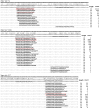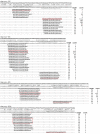MicroRNAs of Bombyx mori identified by Solexa sequencing
- PMID: 20199675
- PMCID: PMC2838851
- DOI: 10.1186/1471-2164-11-148
MicroRNAs of Bombyx mori identified by Solexa sequencing
Abstract
Background: MicroRNA (miRNA) and other small regulatory RNAs contribute to the modulation of a large number of cellular processes. We sequenced three small RNA libraries prepared from the whole body, and the anterior-middle and posterior silk glands of Bombyx mori, with a view to expanding the repertoire of silkworm miRNAs and exploring transcriptional differences in miRNAs between segments of the silk gland.
Results: With the aid of large-scale Solexa sequencing technology, we validated 257 unique miRNA genes, including 202 novel and 55 previously reported genes, corresponding to 324 loci in the silkworm genome. Over 30 known silkworm miRNAs were further corrected in their sequence constitutes and length. A number of reads originated from the loop regions of the precursors of two previously reported miRNAs (bmo-miR-1920 and miR-1921). Interestingly, the majority of the newly identified miRNAs were silkworm-specific, 23 unique miRNAs were widely conserved from invertebrates to vertebrates, 13 unique miRNAs were limited to invertebrates, and 32 were confined to insects. We identified 24 closely positioned clusters and 45 paralogs of miRNAs in the silkworm genome. However, sequence tags showed that paralogs or clusters were not prerequisites for coordinated transcription and accumulation. The majority of silkworm-specific miRNAs were located in transposable elements, and displayed significant differences in abundance between the anterior-middle and posterior silk gland.
Conclusions: Conservative analysis revealed that miRNAs can serve as phylogenetic markers and function in evolutionary signaling. The newly identified miRNAs greatly enrich the repertoire of insect miRNAs, and provide insights into miRNA evolution, biogenesis, and expression in insects. The differential expression of miRNAs in the anterior-middle and posterior silk glands supports their involvement as new levels in the regulation of the silkworm silk gland.
Figures





Similar articles
-
Deep sequencing of small RNA libraries reveals dynamic regulation of conserved and novel microRNAs and microRNA-stars during silkworm development.BMC Genomics. 2010 Jan 20;11:52. doi: 10.1186/1471-2164-11-52. BMC Genomics. 2010. PMID: 20089182 Free PMC article.
-
Novel microRNAs in silkworm (Bombyx mori).Funct Integr Genomics. 2010 Aug;10(3):405-15. doi: 10.1007/s10142-010-0162-7. Epub 2010 Mar 13. Funct Integr Genomics. 2010. PMID: 20229201
-
Insect-Specific microRNA Involved in the Development of the Silkworm Bombyx mori.PLoS One. 2009;4(3):e4677. doi: 10.1371/journal.pone.0004677. Epub 2009 Mar 5. PLoS One. 2009. PMID: 19262741 Free PMC article.
-
Viral-Encoded microRNAs in Host-Pathogen Interactions in Silkworm.Microrna. 2021;10(1):3-13. doi: 10.2174/2211536610666210121154314. Microrna. 2021. PMID: 33475082 Review.
-
Overview of research on Bombyx mori microRNA.J Insect Sci. 2014;14:133. doi: 10.1093/jis/14.1.133. J Insect Sci. 2014. PMID: 25368077 Free PMC article. Review.
Cited by
-
Characterization and comparative analysis of small RNAs in three small RNA libraries of the brown planthopper (Nilaparvata lugens).PLoS One. 2012;7(3):e32860. doi: 10.1371/journal.pone.0032860. Epub 2012 Mar 6. PLoS One. 2012. PMID: 22412935 Free PMC article.
-
Identification of miRNAs and their target genes in developing soybean seeds by deep sequencing.BMC Plant Biol. 2011 Jan 10;11:5. doi: 10.1186/1471-2229-11-5. BMC Plant Biol. 2011. PMID: 21219599 Free PMC article.
-
Let-7 microRNA is a critical regulator in controlling the growth and function of silk gland in the silkworm.RNA Biol. 2020 May;17(5):703-717. doi: 10.1080/15476286.2020.1726128. Epub 2020 Feb 10. RNA Biol. 2020. PMID: 32019402 Free PMC article.
-
High-throughput sequencing of small RNAs from pollen and silk and characterization of miRNAs as candidate factors involved in pollen-silk interactions in maize.PLoS One. 2013 Aug 21;8(8):e72852. doi: 10.1371/journal.pone.0072852. eCollection 2013. PLoS One. 2013. PMID: 23991159 Free PMC article.
-
20-Hydroxyecdysone-responsive microRNAs of insects.RNA Biol. 2020 Oct;17(10):1454-1471. doi: 10.1080/15476286.2020.1775395. Epub 2020 Jun 16. RNA Biol. 2020. PMID: 32482109 Free PMC article.
References
Publication types
MeSH terms
Substances
LinkOut - more resources
Full Text Sources
Other Literature Sources
Molecular Biology Databases

